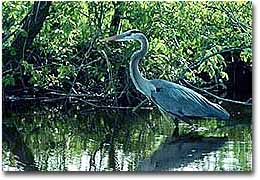
Most of this scenic island, located in one of Maryland's most beautiful coastal bays, is dedicated to wildlife conservation. Its 200 acres of marsh and forests attract waterfowl and marsh birds. Located in Assawoman Bay, Isle of Wight is sheltered from the Atlantic Ocean by the same coastal barrier island that supports Ocean City.
What To See
Isle of Wight attracts many birds dependent upon tidal marshes and bays. Great blue herons and green herons hunt for small fish along the marshy shores. Waterfowl species commonly sighted include black ducks, buffleheads, scaup, brant, Canada and snow geese, and swans. In winter, the laughing call of the common loon adds to the wilderness atmosphere of the island.
What To Do
Boats can be accommodated at the many nearby launching facilities in and around Ocean City. Anglers will enjoy fishing for croaker, sea trout, spot, flounder and bluefish in the waters surrounding the island. Nature photographers are attracted by the diversity of wildlife in and around the water as well as the spectacular views of the Ocean City skyline and Assawoman Bay. Waterfowl hunting is available from portable blinds. Although it is a relatively small area, deer and squirrel may also hunted on the island. Trapping rights are leased yearly.
Area Regulations
- Use of Isle of Wight WMA is generally permitted seven days a week throughout the year.
- Hunting is allowed in accordance with open seasons and shooting hours, unless otherwise noted.
- All State and Federal Hunting Laws and Regulations are applicable.
- Trapping is by permit only.
- Deer hunting by bow, muzzleloader, and shotgun only.
- No hunting South of Rt. 90. This area is managed as a day use recreation area by Worcester County.
- No motorized vehicles are allowed.
Special Areas
- The area south of Route 90 is closed to hunting and is managed as a day use recreation area by Worcester County.
Non-hunting Users Guide
- Non-hunting visitors are welcome.
- Be aware of open hunting seasons and visit accordingly.
- Season dates available in newspapers, on the Internet, and at some area stores.
- Trails are maintained and suitable for hiking, nature photography, birding, hunting and other recreational activities, but are not actively marked.
- The area south of Route 90 is closed to hunting and is managed as a day use recreation area by Worcester County.
- Visitors to the management area should be aware that there may be biting flies, mosquitoes, and ticks present during April - November.
Site Management Goals
- Tidal marsh habitat conditions on the WMA limit management practices that can be implemented.
 Directions
Directions
From U.S. Route 50, take MD 90 east to Isle of Wight WMA. Vehicle access: via parking areas located off Rt. 90 and St. Martins Neck Road. Boat access: via Ocean City public boat ramps. For additional information, contact the Wellington Wildlife Office at (410) 651-2065.
 Click Here for Map
Click Here for Map
Photograph by: Chuck Prahl
This area is a part of Maryland’s Department of Natural Resources public land system and is managed by the Wildlife and Heritage Service. The primary mission of the WMA system is to conserve and enhance wildlife populations and their respective habitats as well as to provide public recreational use of the State’s wildlife resources.
Eighty-five percent of the funding for Maryland's state wildlife programs comes from hunting license fees and a federal excise tax on sport hunting devices and ammunition. The federal aid funds are derived from the Federal Aid in Wildlife Restoration (or Pittman-Robertson) Fund, which sportsmen and women have been contributing to since 1937. Each state receives a share of the funds, which is administered by the U. S. Fish and Wildlife Service; these funds are used for wildlife conservation and hunter education programs, including the management of the WMA system.
Other sources of funds for land acquisition include Program Open Space Funding for Maryland's State and local parks and conservation areas, provided through The Department of Natural Resources' Program Open Space. Established in 1969, Program Open Space symbolizes Maryland's long-term commitment to conserving natural resources while providing exceptional outdoor recreation opportunities.